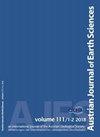In search of the oldest rock of Austria: The Hauergraben Gneiss, a 1.40 Ga old mafic quartz-monzonitic inlayer in the Dobra Gneiss (Drosendorf Unit, Bohemian Massif) as a new candidate
IF 1.1
4区 地球科学
Q2 Earth and Planetary Sciences
引用次数: 3
Abstract
Abstract For a long time, the 1.38 Ga old Dobra Gneiss (Type A) from the Lower Austrian Drosendorf Unit (Moldanubian Zone, Bohemian Massif) was considered the oldest rock of Austria. We now have dated zircons from a local mafic inlayer in the Dobra Gneiss Type A, termed Hauergraben Gneiss. This small-scale amphibole-bearing orthogneiss has a magmatic formation age of 1.40 Ga, and is, thus, to the present state of knowledge, the oldest rock of Austria. Based on geochemical investigations, the protolith of the Hauergraben Gneiss was a quartz-monzonite. It probably originated in a volcanic arc setting like the Dobra Gneiss, but shows distinctively higher transitional metal contents (especially Cr and Co), higher Ba and Sr, and higher light rare earth element contents, which hint at a lithospheric mantle input. This 1.40 Ga old mafic arc material was then incorporated into the 1.38 Ga old intrusive protolith of the Dobra Gneiss, probably in the form of enclaves. Considering the model that the Drosendorf Unit was part of Amazonia until the late Neoproterozoic, we propose that both, Dobra Gneiss Type A and Hauergraben Gneiss, originated at the western margin of the Columbia super-continent, where several long-lived Mesoproterozoic volcanic arcs existed and accreted over time. During the Variscan orogeny, the Hauergraben Gneiss experienced peak metamorphic temperatures of ~620 °C at pressures of ~6 kbar, as can be deduced from amphibole thermobarometry. This is in line with published peak-PT estimates from other parts of the Drosendorf Unit. Formation of secondary low-Al magnesiohornblende at the expense of the earlier edenitic/pargasitic peak amphibole indicates a subsequent retrograde overprint.寻找奥地利最古老的岩石:Hauergraben片麻岩,Dobra片麻岩(Drosedorf单元,波西米亚地块)中一个1.40 Ga古老的镁铁质石英二长岩镶嵌层,作为新的候选者
长期以来,来自下奥地利普罗森多夫单元(波西米亚地块Moldanubian区)的1.38 Ga老多布拉片麻岩(a型)被认为是奥地利最古老的岩石。我们现在已经确定了多布拉a型片麻岩(Hauergraben片麻岩)中本地基性嵌层锆石的年代。这种含角闪岩的小型正长岩的岩浆形成年龄为1.40 Ga,因此,据目前所知,它是奥地利最古老的岩石。地球化学研究表明,豪尔格拉本片麻岩原岩为石英二长岩。它可能起源于像多布拉片麻岩一样的火山弧环境,但明显表现出较高的过渡金属(特别是Cr和Co)含量,较高的Ba和Sr含量,以及较高的轻稀土元素含量,提示岩石圈地幔输入。这些1.40 Ga古老的基性弧物质随后被合并到1.38 Ga古老的多布拉片麻岩侵入原岩中,可能以包体的形式存在。考虑到Drosendorf单元直到新元古代晚期都是亚马逊河流域的一部分的模式,我们认为Dobra A型片麻岩和Hauergraben片麻岩都起源于哥伦比亚超大陆的西缘,在那里存在着几条长寿命的中元古代火山弧,并随着时间的推移而增加。在瓦里斯坎造山运动期间,在~6 kbar的压力下,Hauergraben片麻岩经历了~620℃的峰值变质温度,这可以从角闪孔热气压测量中推断出来。这与从普罗森多夫股其他部门公布的峰值pt估计一致。次级低铝镁角闪石的形成是以早期的岩浆岩/寄生峰角闪石为代价的,表明随后发生了逆行叠印。
本文章由计算机程序翻译,如有差异,请以英文原文为准。
求助全文
约1分钟内获得全文
求助全文
来源期刊

Austrian Journal of Earth Sciences
Earth and Planetary Sciences-Paleontology
CiteScore
3.10
自引率
0.00%
发文量
0
审稿时长
>12 weeks
期刊介绍:
AUSTRIAN JOURNAL OF EARTH SCIENCES is the official journal of the Austrian Geological, Mineralogical and Palaeontological Societies, hosted by a country that is famous for its spectacular mountains that are the birthplace for many geological and mineralogical concepts in modern Earth science.
AUSTRIAN JOURNAL OF EARTH SCIENCE focuses on all aspects relevant to the geosciences of the Alps, Bohemian Massif and surrounding areas. Contributions on other regions are welcome if they embed their findings into a conceptual framework that relates the contribution to Alpine-type orogens and Alpine regions in general, and are thus relevant to an international audience. Contributions are subject to peer review and editorial control according to SCI guidelines to ensure that the required standard of scientific excellence is maintained.
 求助内容:
求助内容: 应助结果提醒方式:
应助结果提醒方式:


